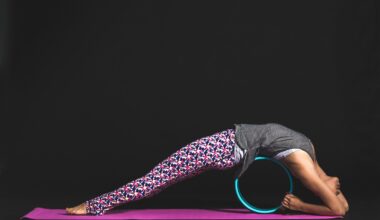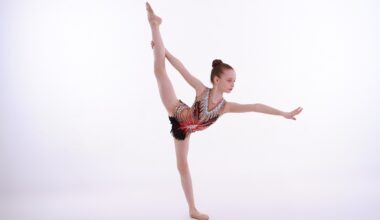Customizing Fitness Spaces for Cognitive Disabilities: Environmental Tips
Creating an inclusive fitness space for individuals with cognitive disabilities involves deliberate environmental adjustments. Recognizing that cognitive disabilities can encompass a wide range of conditions, it’s essential to understand that different needs will require diverse approaches. For instance, maintaining clear signage and simple layouts can significantly improve navigation within the fitness area. Utilize large fonts and high contrast colors to enhance visibility. Moreover, incorporating sensory-friendly materials can assist in reducing anxiety associated with overwhelming sensations. Soft lighting and acoustic panels can make the environment feel more welcoming. Clearly defined exercise zones can also help individuals focus on specific activities without confusion. Utilizing tactile elements, such as textured flooring or wall panels, assists in sensory integration. Another important consideration is accessibility; hence, ensuring pathways are free from obstacles aids mobility. Employing the power of visual supports, like pictures demonstrating exercises, can orient members effectively. Ensuring that fitness equipment is easy to use or adaptable for those with varying functional abilities within the realm of cognitive disabilities promotes a positive experience for all participants. Ultimately, these adjustments can lead to a more supportive and enjoyable fitness environment.
Creating a sensory-friendly environment can play a crucial role in fostering an inclusive fitness space.
Integrating sensory tools and aids can help individuals with cognitive disabilities engage more fully in their fitness routines. For instance, providing noise-cancellation headphones can help create a calming atmosphere, enabling users to focus on their workouts without auditory overload. Consideration should also be given to the textures and colors used throughout the fitness area. Opting for softer colors can create a less stimulating environment conducive to relaxation while exercising. Additionally, you might incorporate adjustable lighting options, allowing individuals to select their preferred environment brightness. It’s also essential to set aside a quiet area within the fitness space where those feeling overwhelmed can retreat. Studies show that calm, filtered sensory inputs contribute positively to mental health and allow individuals to manage stress more effectively. Educating staff about the importance of these tools can further enhance the environment. Ensuring that employees are trained on how to assist individuals adapting to the fitness space is vital, fostering a welcoming atmosphere for all. An informed staff can significantly contribute to ensuring that the fitness journey is comfortable, engaging, and productive for individuals with cognitive disabilities.
Equipment selection is a key aspect of customizing fitness spaces for those with cognitive disabilities.
Choosing adaptable fitness equipment that caters to various skill levels can make a significant difference. For instance, using resistance bands or weighted balls can help facilitate exercise at a pace individuals can manage comfortably. Moreover, ensuring that equipment is user-friendly is essential. Color-coded equipment can simplify the selection process for users, allowing for quick identification of intended uses or difficulty levels. Clear demonstrations of how to use equipment—either via videos or instructional signage—can enhance understanding and confidence. Including equipment with adjustable settings is also beneficial, as it can accommodate different physical abilities and personal preferences. Special attention should be given to the arrangement and spacing of equipment to ensure that individuals have enough room to work safely, promoting confidence in their chosen exercises. Additionally, grouping similar types of equipment together can streamline the experience and help guide choices. Ultimately, ensuring that the fitness space features a variety of accessible, well-organized equipment promotes inclusiveness. This inclusion can cultivate a sense of belonging and empowerment for individuals with cognitive disabilities.
Staff Training and Awareness
Train staff to create an inclusive environment for individuals with cognitive disabilities.
Education is crucial in helping staff understand the unique challenges faced by individuals with cognitive disabilities. Training programs should cover topics such as recognizing signs of distress and adjusting approaches to suit individual needs. Equipping staff with communication strategies can empower them to support users effectively without overwhelming or alienating them. Creating role-play exercises during training sessions can foster empathy and understanding, allowing staff to appreciate the perspective of individuals navigating fitness spaces with cognitive challenges. Furthermore, emphasizing the importance of patience and encouragement can reinforce supportive interactions during workouts. Regular staff meetings to discuss challenges and share experiences can contribute significantly to creating a collaborative atmosphere. Providing continuous training opportunities is also beneficial, ensuring that employees stay informed on best practices and new strategies in adaptive fitness methodologies. Designating a staff member as the point of contact for individuals using the space with cognitive disabilities can assist in fostering trust and communication. A dedicated point can answer questions or provide support during workouts. Cultivating this awareness among fitness staff is critical for creating an inclusive fitness community.
Establishing a feedback mechanism is vital for improving the fitness environment.
Creating a platform where individuals with cognitive disabilities can share their experiences can reveal valuable insights about the effectiveness of adjustments in the fitness space. Through surveys, suggestion boxes, or even informal discussions, users can emphasize aspects of the environment they appreciate and areas needing improvement. It is imperative to ensure the feedback process is straightforward and accessible, allowing individuals to express themselves comfortably. This process cultivates a sense of ownership within the fitness community while also making individuals feel valued. Involving stakeholders, such as family members and caregivers in discussions, can lead to a more comprehensive understanding of the needs present within the fitness community. Additionally, organizing focus groups can facilitate deeper conversations about specific challenges and potential solutions. Both qualitative and quantitative feedback should be analyzed to adopt an evidence-based approach for any necessary changes. Monitoring the implementation of suggested changes also provides a basis for continuous improvement. Ultimately, this cycle of feedback contributes to the overall quality of the fitness experience, ensuring it remains attuned to the needs of its participants.
Creating Community Engagement
Building a community around adaptive fitness is essential for inclusivity.
Engaging individuals with cognitive disabilities in community fitness programs can foster connections and create a supportive network. By organizing inclusive group workouts, the fitness space becomes a place where individuals can build social ties, reducing feelings of isolation. Structured classes that promote teamwork and collaboration can empower individuals to support one another. Additionally, organizing social events centered on fitness, such as community challenges or themed workout days, can raise awareness and encourage broader participation. Encouraging community partnerships with local advocacy groups can also enhance outreach efforts, ensuring that diverse perspectives inform programming. Such partnerships can amplify awareness about available resources, allowing families and caregivers to support individuals in accessing fitness opportunities. Highlighting stories of individuals who have successfully engaged in adaptive fitness can inspire and motivate newcomers. Promoting a culture of acceptance and encouragement within the fitness community is vital. Emphasizing that the fitness space is welcoming and accommodating can significantly impact individuals’ willingness to participate. Ultimately, fostering a stronger sense of belonging can go a long way toward supporting the wellness journey of individuals with cognitive disabilities.
Regular assessment of the fitness environment ensures its adaptability to user needs.
As individuals grow and develop, their fitness requirements may shift, making periodic evaluations essential. Establishing a systematic assessment process can identify areas for improvement, ensuring that the environment remains conducive to a diverse range of cognitive disabilities. Engaging users in these evaluations encourages self-advocacy while providing them a voice in shaping their fitness journey. Moreover, collecting data on user preferences and behaviors helps inform future adaptations to the space. Observing how individuals interact with the environment can shed light on opportunities for optimizing space layout, signage, and equipment accessibility. Involving staff in these assessments promotes a holistic perspective on user experiences and challenges. Documenting changes and outcomes based on assessments can highlight successful adaptations, valuable for staff training. Feedback from these evaluations can augment existing knowledge among fitness professionals. Subsequently, creating an adaptive fitness model that evolves and grows with its community ensures that users experience consistent support tailored to their changing needs. Ultimately, fostering this ongoing evaluation process is vital for creating a dynamic and inclusive fitness environment for individuals with cognitive disabilities.
Lastly, innovation in fitness offerings addresses emerging needs effectively.
Incorporating technology into fitness programs can enhance the experience for individuals with cognitive disabilities. For example, using mobile apps designed specifically for adaptive fitness can assist individuals in tracking their workouts or connecting with trainers. Virtual reality may also provide immersive exercise experiences. Exploring various technology options and soliciting user feedback can facilitate innovative programming solutions that resonate with users. Moreover, utilizing data-driven insights can provide an accurate picture of fitness trends among this demographic. Facilitating technology training for both staff and users can enhance the overall fitness experience. By incorporating gamification elements into workouts, individuals can engage more dynamically with their fitness routines. Be it through challenges, rewards, or online communities, these elements can enhance motivation. Keeping the offerings exciting and engaging can attract a broader audience. Establishing partnerships with tech companies can lead to innovative fitness initiatives and resources. Ultimately, a proactive approach to integrating technology ensures that the fitness environment can respond to users’ evolving needs. Combining both traditional and cutting-edge fitness solutions aids in creating a welcoming atmosphere where all individuals can thrive.


